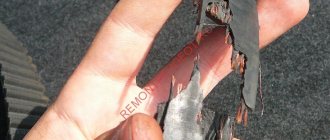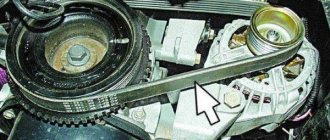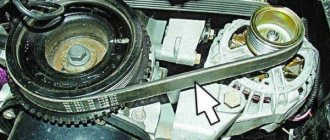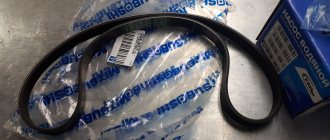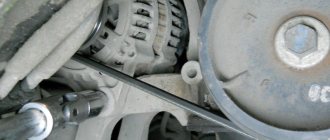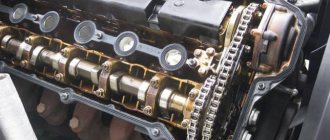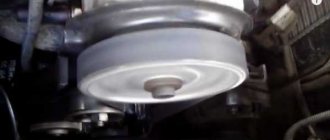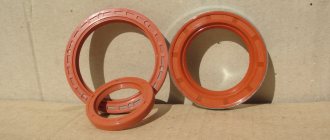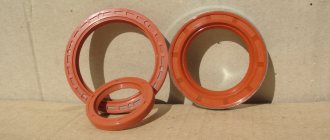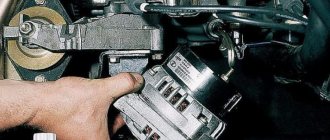Home » Repair tips » Broken timing belt and possible consequences - causes, symptoms, repair 846
In most cases, when the timing belt breaks, a popping noise is heard and the engine stalls, although all other car components continue to function normally. Restarting the engine in this case is most often accompanied by a metallic knock and ease of rotation by the starter, due to the lack of compression in the cylinders.
When the first suspicions arise, you should stop the car and lift the hood to inspect the condition of the belt, if there is such a possibility with quick access, as a rule there is no such possibility.
Why does the timing belt break?
Causes of product damage:
- low quality belt;
- errors made during installation or replacement;
- failure of the tensioner rollers;
- wear of the belt teeth (the teeth wear out constantly during the operation of the car);
- pump jamming;
- foreign objects entering the gas distribution mechanism.
Late replacement
The service life of modern new products for distribution mechanisms depends on the make of the car and is about 150 thousand kilometers (on older cars this figure is lower - about 70 - 100 thousand / km). If the vehicle is used in low temperature conditions, the service life of the belt is reduced to 60-100 thousand/km. In any case, experts recommend diagnosing the condition of the timing belt at least every 15 thousand kilometers.
Quality of spare parts
Quality determines the correct ignition of the air-fuel mixture, which affects the efficiency of the power unit. Installing and using cheap products in the machine can cause low drive tension, which will result in the belt quickly bursting.
Incorrect belt replacement
Errors made when installing the timing belt lead to asynchronous opening and closing of the valves, resulting in reduced engine power. The cause is usually too loose or too high a tension on the shafts. If the replacement of the product was carried out with errors, it may break after 1-2 thousand kilometers.
Characteristic signs of incorrect replacement:
- the product slides to the side;
- cracks have appeared or become noticeable on its surface;
- An unusual sound is heard when the engine is running.
Broken tension rollers
Tensioner rollers are designed to tension the belt on the engine shafts, so that it does not jump off while the engine is running. If the tension is weak, the strap will begin to slip, which will cause an increase in temperature and rapid wear of the auxiliary units. If the tension is excessive, the product can quickly burst, and a characteristic symptom will be a sharp sound from under the hood.
Destruction of timing belt teeth
With serious wear, the rubber teeth located in mesh with the shaft gears break off. With such a problem, the engine may not start, although the belt itself appears to be intact. The operation of the power unit as a result of tooth destruction is disrupted, as this leads to a failure of the ignition system.
Pump wedge
If the pump is jammed, it may not respond to turning, which leads to strong tension and breaking of the belt while the vehicle is moving. This problem is more relevant for domestic vehicles.
Foreign elements
If foreign elements get into the distribution mechanism (this could be dirt, small stones, engine oil), the camshaft or crankshaft may jam. To avoid this problem, it is necessary to periodically check the protective cover and fastenings.
Video: causes of timing belt damage
In the video, user Igor Belov spoke in detail about why the timing belt breaks.
Should I change the pump when replacing the timing belt on a Peugeot?
Disputes on this topic have not stopped to this day. Moreover, opinions often differ radically: from ardent opponents of replacing a car’s engine pump in general, citing the quality of the automaker’s components, to supporters of replacing it every 40 thousand kilometers.
In the latter case, this is the resource of the timing belt of many Chinese cars, where the advisability of replacing it together with the engine pump is decided by car service technicians from the Middle Kingdom. The safety margin of the timing belts of the European automobile industry is much higher (60-100 thousand kilometers), so specialists from specialized service stations still recommend changing the engine pump during timing belt maintenance.
In fact, the engine pump is part of the timing belt drive and it is still better to change it as a whole, like the same rollers, for example. If you are a supporter of austerity, then think about the possible consequences of a worn pump jamming and a broken belt as a consequence. The cost of repairs (including replacement of valves) can then be disproportionately higher than the price of the pump.
What are the signs of a broken belt?
You can determine that the timing belt has broken by the following “symptoms”:
- Abrupt stopping of the engine and inability to start it. Attempts to start the power unit only worsen the situation, since the piston causes new damage to the failed valve.
- After a belt breaks, engine operation may be accompanied by a metallic knock and ease of rotation of the crankshaft by the starter. This is due to the lack of compression in the engine cylinders, as a result of which nothing holds the pistons.
Video: how to determine if the timing belt has broken
The video from the Renault Repair channel describes in detail how to independently determine whether the timing belt is damaged or broken.
Danger of malfunction
It has long been no secret to more or less experienced motorists that monitoring the serviceability of some components significantly extends the service life of others. This rule applies more than ever to the timing belt we are considering today. This state of affairs is largely due to the fact that the gas distribution mechanism drive performs the most important function, connecting its elements into a perfectly functioning system. The latter, by the way, ensures the synchronous operation of the valves and pistons of the engine, and in such a way that they do not interact with each other at all and serve their full operational life.
The operation of the timing belt is truly debugged, however, even in such a device a failure can occur. The most dangerous of these, primarily for the condition of the engine, is a broken belt. This malfunction provokes asynchronous operation of the valves and pistons of the motor, which results in the following sequence of phenomena:
- At first the valves get stuck in the open position;
- Then the pistons begin to hit them. The impacts continue until the engine, which has lost compression, stalls;
- As a result, either valves, pistons, or other engine elements (cylinder head, valve tracks, timing belt) fail and require expensive repairs.
What are the consequences of a broken timing belt?
The most serious consequence of a broken timing belt is damage to the valves, as a result of which the car owner is faced with the need to overhaul the unit and restore the gas distribution mechanism. This can happen while the engine is running, when the pistons move continuously from top dead center to bottom dead center. The rupture occurs during the release of gases or fuel injection (at this time the piston moves down). In this case, the movement of the pistons in the cylinder continues and parts of the device collide with each other.
If the timing belt breaks, the extent of the consequences will depend on the characteristics of the engine and the conditions under which the breakdown occurred:
- Due to a broken belt, the camshaft stops rotating, causing the valves to stop in one position. At this moment, the crankshaft continues to move by inertia and the pistons go to the open valves, which immediately bends. On some power units, for example, on the VAZ 2111, 8 cl, the pistons are equipped with special recesses, thanks to which contact with the valves is excluded in the event of a break. But, modern engines are designed to provide the greatest power with a minimum volume, so the pistons do not have recesses.
- If the belt breaks at idle, only a few valves may be damaged. Moreover, the higher the rotation speed of the crankshaft, the higher the likelihood of failure of the guide bushings. This problem causes a major overhaul or replacement of the cylinder head.
- On a diesel engine, the consequences of a broken timing belt will be destruction of the valve, camshaft with bearing elements, cylinder head, connecting rods and pushers. This is due to the design of such motors, due to which the valves have virtually no free play when the piston is in the top dead center position.
- For cars equipped with a Japanese engine, when the timing belt breaks, damage to all valves, breakage of bushings, pistons and cylinder heads are typical. Such malfunctions are typical when the machine is moving at high speed.
How long can you drive on a broken belt?
It is important to know
After the timing belt breaks, you should not attempt to continue driving.
Video: the dangers of a broken timing belt
The video from the Car Program channel describes the consequences that a car owner will face if the timing belt breaks.
What to do after a belt breaks?
If the timing belt is broken, then:
- It is necessary to open the engine compartment and lift (or completely dismantle) the protective cover of the mechanism.
- It is important to carefully evaluate the appearance of the belt (the torn product will be visible). If it breaks at the very bottom, you will need to turn the crankshaft half a turn to find it.
- The vehicle must then be towed to a garage or service station. If the car is equipped with an automatic transmission, the assistance of a tow truck will be required, since towing is not allowed on such vehicles.
How to replace the timing belt yourself?
Good to know
16-valve engines are equipped with two camshafts with a separate gear for each. Before making a replacement, the user should look in the service manual to see where the timing marks are located and what type they look like.
Algorithm for replacement:
- The engine compartment of the car is opened, the negative terminal is disconnected from the battery (the ignition must first be turned off).
- The wheel is removed from the belt side. To do this, you need to jack up the car and unscrew the bolts with a wheel wrench.
- Then the engine cover and the protection of the power unit are dismantled (the bolts or screws are unscrewed). You will also need to remove the generator drive belt. Depending on the design features of the engine, it may be necessary to dismantle the expansion tank with power steering oil or adsorber. In some cars you need to remove the air conditioner bracket, air intake, intercooler with terminals.
- Using a hexagon, it is necessary to unscrew the bolts securing the protective cover of the strap and gears.
- If the car is equipped with a crankshaft position sensor, it is necessary to disconnect the block with cables from the device.
- Then the timing belt tensioner pulley bolt is unscrewed and the bearing itself is removed. If the system is equipped with a guide or support roller, this must also be removed.
- The worn timing belt is being dismantled.
- The position of the mark on one or two camshaft gears is checked (depending on the 8- or 16-valve engine). It is always important to check that these marks match the marks on the timing drive. If they do not match, you need to combine them with each other yourself. To do this, turn the camshaft with a key.
- If you need to check the alignment of the marks on the gears with the mark on the oil pump body, you must remove the toothed pulley with a special washer. If the screw does not come out, rest the handle of the L-shaped key against the rod, connect the battery and crank the starter once. After this, the battery must be disconnected.
- The next step is to install the support roller, if it is provided for by the engine design.
- The new belt is first placed over the crankshaft sprocket and then wound onto the support roller, camshaft sprocket and pump gear. When performing this task, you should monitor the location of the marks on the camshaft gears. If the risks have gone astray and no longer match, they must be set again.
- Next, install the tension roller and tighten it (you need to screw it without tightening it until it stops).
- Check the evenness of the belt lining. Then it is tightened using a special wrench (the roller must be turned counterclockwise). Next, holding the latter with a tool, you need to fix its position by tightening the mounting screw (all the way).
- The product tension is diagnosed - you need to turn the belt lengthwise using your fingers. It should rotate no more than 90 degrees.
- At the final stage, it is necessary to return all removed parts and spare parts to their places.
- The engine is started and its operation is assessed (by ear). If the product is installed correctly, there should be no abnormal sounds.
When installing the timing belt yourself, it is important to pay attention to:
- the presence of a hum and whistle of the roller, which indicate the belt is overtightened;
- detonation - weakening of its tension;
- black smoke from the exhaust pipe - incorrect markings on the shafts.
Preventive measures
Good to know
The main preventative measure for timing belt breakage is its timely replacement.
Additional preventive measures include:
- Use of high-quality original spare parts.
- Periodic monitoring of the tension level of the product, the condition of the pump and rollers. It is important that the tension is uniform in all areas, without sagging.
- External assessment of the belt condition. If the first signs of damage and cracks appear on the product, the user needs to replace the timing belt as soon as possible.
Valves - bend or not
The answer to this question lies in the design. If the car has a timing belt, then if it breaks, it will, of course, bend the valves. This will not only damage these elements, but also possibly damage the block head. So, chips and cracks may appear directly in the element itself. With this, you will have to change the guide bushings, which also become deformed.
Of course, these are not all the consequences that a car enthusiast can expect. Bent valves and damage to the cylinder head can result in large amounts of gasoline and possibly coolant entering the cylinders. All this will damage the piston group.
vote
Article rating
